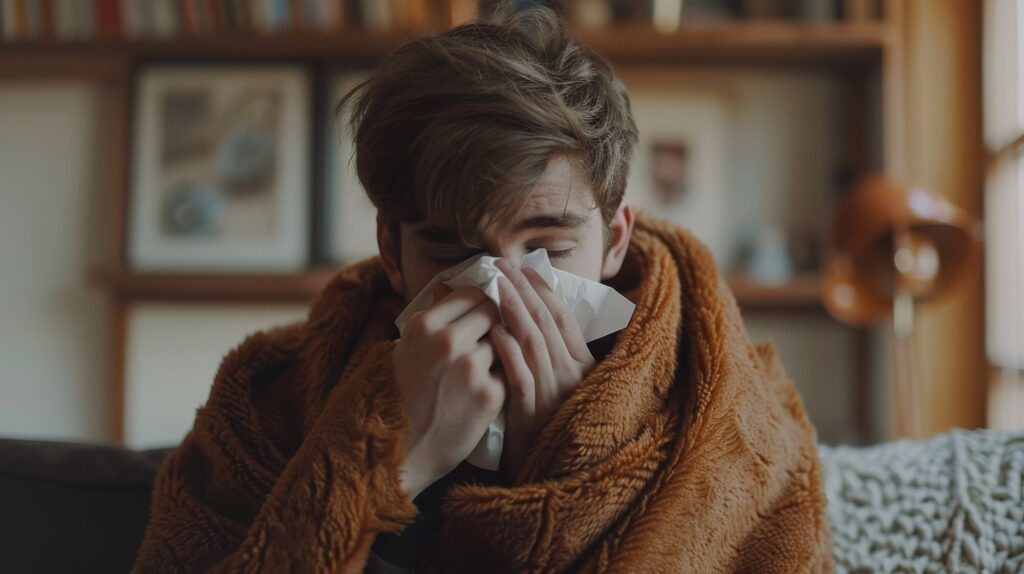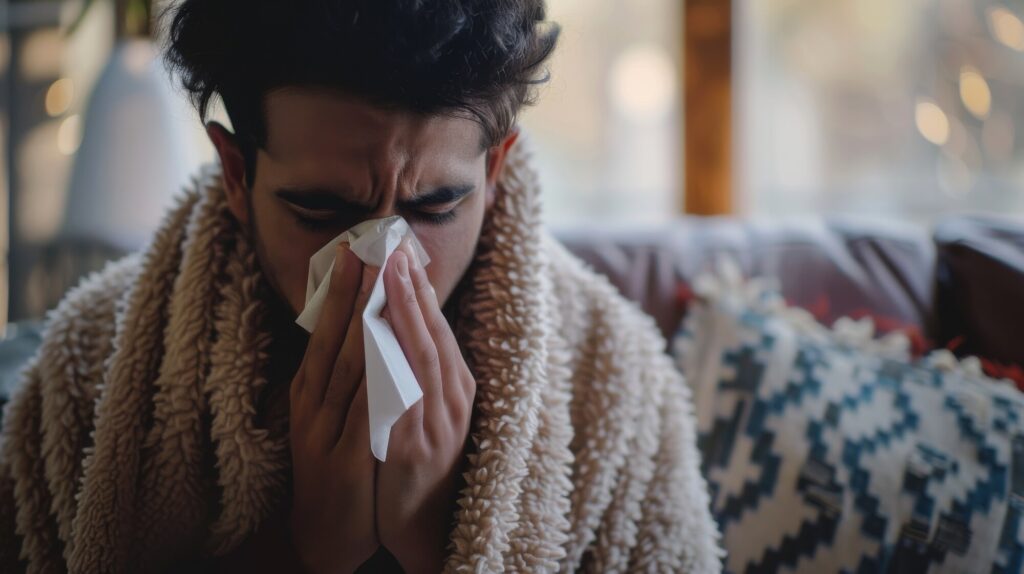Sleeping in a stuffy, hot environment can make it difficult to fall asleep, stay asleep, and remain comfortable throughout the night. While using a fan might seem like an easy solution for a cool night’s sleep, it may not be as effective or comfortable as you think.
Research has shown that a lower body temperature (preferably between 65 and 68°F, or even as low as 60°F) promotes more restorative sleep.
In this article, we’ll discuss the downsides of using a fan at night and offer better alternatives for sleeping comfortably.
Is Sleeping with a Fan Bad for You?
Many people, especially in warmer climates, rely on fans to keep cool at night. However, few are aware of the potential health risks associated with this seemingly harmless method of cooling.
Here are some reasons why you might want to reconsider using a fan while you sleep:
1. Worsen Allergies

Fans can stir up dust, pollen, pet dander, and other allergens in the air, which can trigger allergies and respiratory issues. The movement of air from the fan may release allergens that accumulate on the fan blades or air filter, worsening symptoms like congestion, sneezing, and itchy eyes.
Regularly cleaning the fan blades and air filter can help reduce allergens and alleviate allergy symptoms. Studies have even linked seasonal allergies to snoring and sleep disruptions.
2. Increase Sinus Irritation

The continuous airflow from a fan can dry out your mouth, throat, and nasal passages, irritating your sinuses and causing your body to produce excess mucus. This can lead to congestion, headaches, and sore throats.
If you suffer from allergies or cold-like symptoms, the fan’s constant breeze can make things worse. To mitigate this, consider using a humidifier or placing a glass of water next to your bed.
3. Cause Stiff or Sore Muscles

Waking up with a stiff neck or sore muscles can be a result of prolonged exposure to the direct airflow of a fan. This is particularly common if the fan is positioned near your face or neck, as the continuous breeze can cause muscles to tighten, leading to discomfort.
To avoid this, reposition the fan so that the airflow doesn’t hit your body directly. Angling the fan so that the air circulates the room without focusing on you is a better solution.
4. Dry Skin and Irritated Eyes

If you already have dry skin or eyes, the fan’s constant airflow can worsen the condition. The dry air can strip your skin and eyes of moisture, leading to dryness, tightness, and irritation.
This issue is especially prominent for people with sensitive skin or those who wear contact lenses. If you have dry skin or eyes, it’s important to carefully consider whether using a fan is the best option for you.
5. Increased Congestion

A fan’s air circulation can dry out your throat, nose, and mouth, prompting your body to produce more mucus. This can worsen symptoms of congestion, stuffy noses, and snoring.
If you’re already sick or congested, the fan might not make you sick, but it can make your symptoms feel worse. Drinking plenty of water and using a humidifier alongside the fan can help alleviate congestion.
6. Potential Noise Disruption
For light sleepers or those who prefer a quiet sleeping environment, even the soft hum of a fan can disrupt sleep. The constant noise, ranging from a gentle buzz to a louder hum, can disturb the sleep-wake cycle, leading to difficulty falling asleep or staying asleep.
If you’re sensitive to noise, a fan’s sound may lead to less deep or more fragmented sleep. Some people may also find it difficult to adjust to the constant noise, causing long-term sleep disruptions.
7. Interrupted Sleep

Nighttime airflow from a fan may also cause you to wake up more frequently, further interrupting your sleep. The same device you’re using to stay cool might actually be causing discomfort and worsening your sleep quality.
A better solution for staying cool and comfortable at night is a cooling mattress pad. These pads help maintain your body temperature throughout the night and are much more effective at preventing overheating than a fan.
8. Limited Temperature Control
A fan can’t actually lower the temperature in a room. While it creates a wind-chill effect that makes you feel cooler, it doesn’t change the room’s actual temperature or your body’s core temperature. In hot weather, a fan merely circulates the already-warm air, offering only temporary relief.
Unlike air conditioners, which cool the air, fans don’t remove heat from the room, making them ineffective in extremely hot conditions.
How to Sleep Cooler at Night
While fans have their limitations, there are other ways to sleep cool and comfortably:
- Use breathable, cooling bedding.
- Take a warm shower before bed.
- Hydrate before sleeping.
- Use blackout curtains to block heat from the sun.
- Try a cooling mattress pad or mattress topper.
For a deeper dive into practical strategies for staying cool and improving your sleep, check out our blog for more tips.
Final Thoughts
While fans are commonly used to stay cool, they come with several drawbacks, such as exacerbating allergies, drying out your skin and eyes, causing muscle stiffness, and potentially disturbing your sleep with noise.
It’s important to balance these factors with your personal comfort and sleep needs. Instead of relying on a fan, consider using breathable bedding, cooling mattress pads, or other alternatives that won’t have the same negative effects. For optimal sleep, aim to create a comfortable, cool environment that suits your individual needs and promotes restorative rest.
Lucky Colors for the 12 Zodiac Signs
Each zodiac sign has specific lucky colors that can enhance positive energy, bring good fortune, and boost confidence. Here are the lucky colors for each sign:
♈ Aries (March 21 – April 19)
🔥 Lucky Colors: Red, Orange, Scarlet
🔺 Why? These bold and fiery colors enhance Aries’ passion, confidence, and leadership.
♉ Taurus (April 20 – May 20)
🌿 Lucky Colors: Green, Pink, Earthy Tones
🔺 Why? Green symbolizes growth and stability, while pink brings harmony and love.
♊ Gemini (May 21 – June 20)
💛 Lucky Colors: Yellow, Light Green, White
🔺 Why? These colors boost Gemini’s communication skills, creativity, and adaptability.
♋ Cancer (June 21 – July 22)
🌊 Lucky Colors: Silver, White, Light Blue
🔺 Why? These soothing colors reflect Cancer’s emotional depth, intuition, and connection to the moon.
♌ Leo (July 23 – August 22)
☀️ Lucky Colors: Gold, Orange, Yellow
🔺 Why? These royal and radiant colors highlight Leo’s charisma, confidence, and strength.
♍ Virgo (August 23 – September 22)
🌾 Lucky Colors: Green, Brown, Beige
🔺 Why? Earthy and natural tones enhance Virgo’s practicality, wisdom, and sense of order.
♎ Libra (September 23 – October 22)
🎀 Lucky Colors: Pink, Blue, Pastel Shades
🔺 Why? These colors promote Libra’s sense of balance, love, and diplomacy.
♏ Scorpio (October 23 – November 21)
🖤 Lucky Colors: Black, Dark Red, Burgundy
🔺 Why? These deep colors represent Scorpio’s mystery, intensity, and transformation.
♐ Sagittarius (November 22 – December 21)
💜 Lucky Colors: Purple, Royal Blue, Dark Yellow
🔺 Why? These colors enhance Sagittarius’ adventurous, spiritual, and optimistic nature.
♑ Capricorn (December 22 – January 19)
🖤 Lucky Colors: Black, Gray, Dark Green
🔺 Why? These colors reflect Capricorn’s discipline, ambition, and grounded energy.
♒ Aquarius (January 20 – February 18)
🔵 Lucky Colors: Blue, Electric Blue, Silver
🔺 Why? These colors enhance Aquarius’ innovation, originality, and connection to the future.
♓ Pisces (February 19 – March 20)
🌊 Lucky Colors: Sea Green, Lavender, Aqua
🔺 Why? These dreamy colors boost Pisces’ creativity, intuition, and emotional depth.
Using these lucky colors in clothing, accessories, or surroundings can help attract positive energy and success! 😊